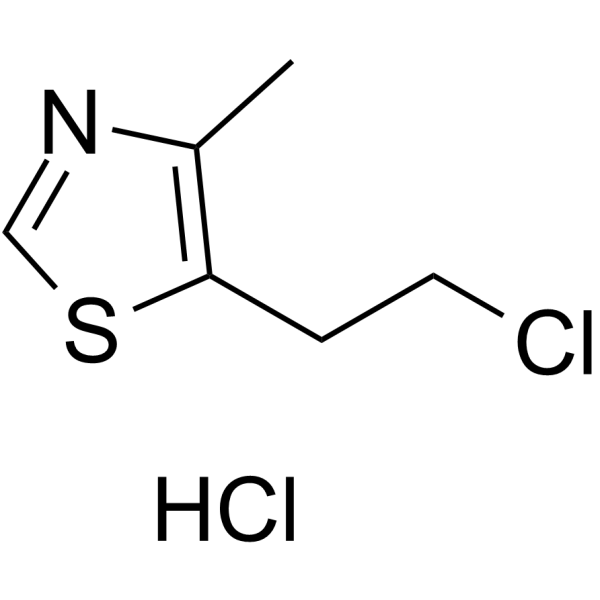
Chlormethiazole hydrochloride
CAS No. 6001-74-7
Chlormethiazole hydrochloride( Clomethiazole hydrochloride )
Catalog No. M26108 CAS No. 6001-74-7
Chlormethiazole hydrochloride is an anticonvulsant and sedative.
Purity : >98% (HPLC)
 COA
COA
 Datasheet
Datasheet
 HNMR
HNMR
 HPLC
HPLC
 MSDS
MSDS
 Handing Instructions
Handing Instructions
| Size | Price / USD | Stock | Quantity |
| 5MG | 27 | Get Quote |


|
| 10MG | 46 | Get Quote |


|
| 25MG | 87 | Get Quote |


|
| 50MG | 170 | Get Quote |


|
| 100MG | 290 | Get Quote |


|
| 200MG | 430 | Get Quote |


|
| 500MG | 695 | Get Quote |


|
| 1G | Get Quote | Get Quote |


|
Biological Information
-
Product NameChlormethiazole hydrochloride
-
NoteResearch use only, not for human use.
-
Brief DescriptionChlormethiazole hydrochloride is an anticonvulsant and sedative.
-
DescriptionChlormethiazole hydrochloride is an anticonvulsant and sedative. It is neuroprotective and prevents the degeneration of serotonergic nerve terminals induced by 3,4-methylenedioxymethamphetamine (MDMA).
-
In Vitro——
-
In Vivo——
-
SynonymsClomethiazole hydrochloride
-
PathwayOthers
-
TargetOther Targets
-
RecptorEGFR| EGFR (T790M/L858R)| ErbB2| ErbB4
-
Research Area——
-
Indication——
Chemical Information
-
CAS Number6001-74-7
-
Formula Weight198.11
-
Molecular FormulaC6H9Cl2NS
-
Purity>98% (HPLC)
-
SolubilityIn Vitro:?DMSO : 125 mg/mL (630.96 mM)
-
SMILESCC1=C(CCCl)SC=N1.Cl
-
Chemical Name——
Shipping & Storage Information
-
Storage(-20℃)
-
ShippingWith Ice Pack
-
Stability≥ 2 years
Reference
1.Xie H, Lin L, Tong L et al. AST1306, a novel irreversible inhibitor of the epidermal growth factor receptor 1 and 2, exhibits antitumor activity both in vitro and in vivo. PLoS One. 2011;6(7):e21487.
molnova catalog



related products
-
Hexyl nicotinate
Hexyl nicotinate (AI3 15769) is a cutaneous vasodilator and can be used in research on non-immunologic contact urticaria on the scalp, face, and back.
-
5-Fluoromethylornith...
5-Fluoromethylornithine dihydrochloride (5-FMOrn dihydrochloride) is a selective inhibitor of L-Ornithine:2-oxoacid aminotransferase (OAT) and a specific inactivator of OAT, which can be used to study metabolic diseases and neurological diseases.
-
6-Hydroxycoumarin
6-Hydroxycoumarin exhibits cytotoxicity against human HL60, HCT116, COLO205 cells with activity value of 35 uM, 42 uM, 37 respectively.



 Cart
Cart
 sales@molnova.com
sales@molnova.com


